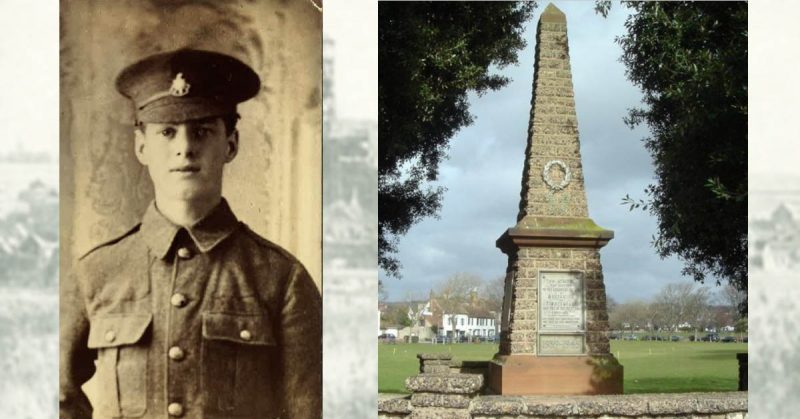War History Online proudly presents this Guest Piece from Bev Pook, assisted by Andy Bailey.
George William Short was born in Southwick Sussex in the last months of 1896, the second son of Nathaniel Edward Short, and Martha Short (nee Strutt).
Georges father, Nathaniel was a mariner and an ugger for Penneys the yacht builders based in Shoreham Harbour West Sussex.
Nathaniel and Martha had eleven children in all, of which ten survived to be included in the 1911 Census. They were all living at the family home at 8 Albert Road Southwick. The children were Merci Mary Short, Nathaniel Edward, Elizabeth Beatrice, George William, Ivy Kathleen, Geoffrey Baden, Dorothy Rosabelle Natalie, Harry J, Winifred Muriel and the youngest Mavis Short.
George’s birth was registered in the first quarter of 1897 and he was baptised on 26 September 1897, by 1911 he was employed as a golf caddie at the old Southdown Golf Club in Southwick.
On 26 April 1912, at the age of 17 years and 10 months, George’s older brother Nathaniel enlisted in the Territorial Force for a term of 4 years. He was to serve as a Driver (service number T/242) with a Brighton based unit of the Army Service Corps.
In the first week of September 1914 George and about 30 others enlisted in Hove on the same day for service in the New (pals) Army battalions that were being raised for the Royal Sussex Regiment (RSR).
They must then have travelled over to the depot at Chichester & been allocated concurrent service numbers. 26 of them served overseas, 15 were killed or died of their wounds.
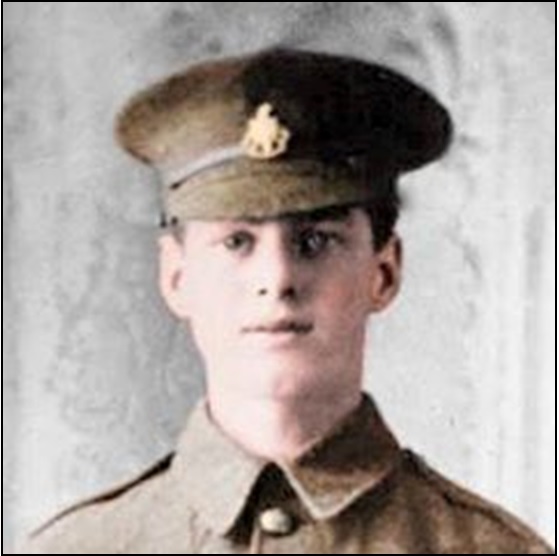
It seems George was one of 4 lads who were accepted for military service on that day even though they were under age, the youngest being 16. (The recruiter obviously had ‘poor eyesight’). Sadly three of four of these young soldiers were to fall. I would say that it is pretty likely that most knew one another and had joined up together. This gives a bit of insight into the days surrounding George’s enlistment. I guess they then took the train along the coast to Chichester to the depot, and then probably marched up South Street to the cross and onwards up North Street to the barracks.
He became Private G/1173, and it is likely he was assigned to the 8th (Service) Battalion, Royal Sussex Regiment.
Having initially travelled to the Regimental Depot at Chichester, George and his fellow recruits began their basic training. It was envisaged that the first of the New Army infantry battalions would be available for overseas service after a period of about 12 months of training.
Whilst the Territorials were absolved from overseas service by the terms of their enlistment, it had become apparent from the losses in France in the first months of the conflict that an immediate supply of manpower was needed to reinforce the fighting units until the New Army was deemed operational. Initially it was conceived that the Territorial units would serve in the Empire, releasing Regular units to return to the European theatre of war, however this was rapidly adjusted to include the use of the Territorials in France and Belgium. The men were urged to volunteer to waiver their home service clause in favour of ‘Imperial Service’. On 19 December 1914, as George trained on the hills above the Sussex coast, his elder brother Nathaniel arrived in France to serve with the British Expeditionary Force (BEF).
…………………..
The winter of 1914-15 had been particularly harsh, and the units in France suffered numerous casualties due to the conditions that were experienced. The Regular units were suffering form a shortage of replacements and therefore the obvious source of fresh manpower were the New Army battalions training in the United Kingdom. As such, George was one of the men selected to leave his New Army unit and travel to France to join the BEF as reinforcement.
George landed in France on 4 January 1915. As part of a draft of 210 men destined for the 2/RSR he travelled towards the front line via ANNEQUIN, arriving with the battalion at 2.10 pm on 13 January 1915. The men were immediately moved into the front line trenches near the CUINCHY brick stacks, an area of the battlefield to the south of the LA BASSEE CANAL. The young civilian soldiers of the New Army joined the seasoned professionals of the Regular Army, many of whom had been fighting since September 1914. The Battalion War Diary refers to the initial impression the Regulars had of their new comrades; “They seem to be a good lot.”
George joined the unit as they held the line to the south of the LA BASSEE CANAL, east of the village of CUINCHY. The battalion began a period of holding the front line before withdrawing to support reserve lines, then finally to billets in nearby villages out of direct fire. Having spent 3 days in the font line, mainly occupied with improving the trenches and defences, the 2/RSR were relieved to billets in ANNEQUIN on 16 Jan. Conditions in the front line at this time were so arduous that the medical authorities advised that units should be rotated through the trenches in a 48 hour cycle. In ANNEQUIN the men were given the opportunity to bathe, and received new underclothing from England.
…………………
The Battle of Aubers Ridge, the blackest day for the 2nd battalion
At 2pm on 6 May 1915 Pte George Short and the men of 2/RSR marched out of ALLOUAGNE, bound for the front line and the latest British Army offensive on the Western Front. They spent the night in billets at LES FACONS where they initially received orders for the attack to take place the following day, before receiving further notification that the attack had been postponed 24 hours. On the evening of 8 May the battalion moved up to occupy the breastworks on the frontage of 400 yards left of the ‘CINDER TRACK’ at RICHEBOURG L’AVOUE, having drawn bombs and wooden bridges to cross the stream to the front of their line.
At 3.30am on 9 May 1915 tea and rum was shared out amongst the men and at 5am the artillery bombardment of the German front line began. This intensified 30 minutes later when the bombardment lifted and the advance began. The lead elements climbed out over the parapet to assemble in No Mans Land and began to move towards the German line east of THE BOARS HEAD.
The advance was opposed by withering machine gun and rifle fire, particularly from the angle of German frontage to the east of the 2/RSR left flank, where the adjoining unit had faltered and failed to advance. The majority of the battalion failed to move more that 150 yards from their front line, less than half way across No Mans Land. Some advanced to within 40 yards of the German wire and one man was seen to reach the German parapet. Orders were received at 6.30 am to retire to the British front line parapet under the cover of a renewed artillery bombardment, and survivors were still returning to the line after darkness fell. Later in the evening, the remains of the battalion marched back to billets in LES CHOQAUX. Here losses were assessed. The battalion had entered the action approximately 850 men strong, however the casualties reported were:
Officers: 2 Killed, 9 Wounded, 3 Missing
Other Ranks: 101 Killed, 329 Wounded, 118 Missing.
With a total of 548 casualties, Private George William Short had ‘gone over the bags’ and had managed to survive the worst day that his battalion was to experience on the Western Front, the ‘Blackest Day’.
The survivors of the battle were marched rearwards on 11 May, to billets in OBLINGHEM and then on the 12 May to billets in BETHUNE.
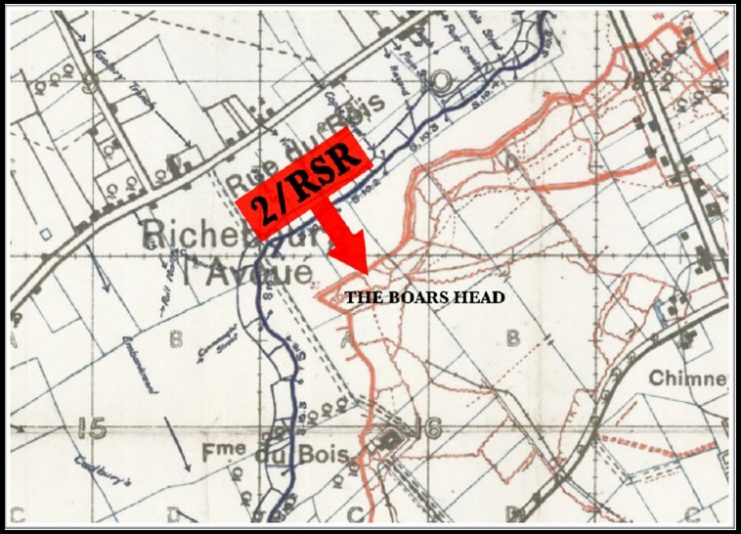
It was here George wrote a letter to his mother “Martha” on the 13th May 1915 whilst resting in billets at Bethune just three days after the battle.
It was printed by “The Sussex Daily News” on the 20th May in their letters from the front column which was dedicated to the Royal Sussex Regiment.
George wrote:
I am sorry to have to tell you that poor F Bowles and P Smith are wounded. We had a big fight on Sunday, (your birthday if you remember). I wrote a letter to you on Friday to wish you many Happy returns of the day but could not get it posted, so I carried it with me into the scrap. I am sending it within this letter, so it is worthwhile keeping and you would think so if you knew what it went through while in my possession.
Well, on Saturday night we moved up to the place we had to charge. On Sunday morning, at 04:30, our first gun spoke and fired a few “coal boxes” til 05:00 and then all the guns started. The earth seemed to shake and tremble, shells flew over our heads and you couldn’t hear what the next man said to you, if you tried.
It was like one continued roll of thunder, we all thought there could not be one possible man alive in front of us. Smoke and dust and all manner of things were flying about over the German lines. Then after half an hour of this we had the order to charge. We all streamed out over the parapets and lined out beautifully. We advanced till we got just over a hundred yards from the Germans, and then there machine guns started on us. They absolutely mowed our chaps down and we flopped down and remained as still as mice.
Poor old P Smith was next to me and he got hit in the arm. Tell Mrs Smith not to worry; he’s all right. The next two on my left were wounded and the next poor fellow was dead. Our officer got up to advance and was shot in the leg. It was murder. How they managed to keep all right under that terrific bombardment, I don’t know.
Well we laid there for a little while and then we started to make a hole to dig ourselves in. Our entrenching tool was our real pal. We remained there all day, with shells and bullets flying over us. Our company, which went out with 260 men or more and 5 officers had as many as 200 casualties.
I don’t know what happened to the trenches after we left, whether they were taken or not, but the aeroplanes that went up said we had fewer casualties than the Germans. If that is so they must have lost a great number of men. You should have seen our poor chaps try to crawl back. I started to at about 5.30 and it was one of the most risky things I have ever attempted. When we got in, I and another chap went back to find the regiment, or what was left of it, and found it behind the firing line. Then we marched to a barn and had two nice blankets each and hot tea and rum and plenty of it. Of course we have felt the effect of the strain these past few days, otherwise there is nothing much wrong with me.
Pete has joined us, but he’s in another platoon. My pal has been shifted to another platoon, so I’m rather on my own. Still I keep on smiling and I am not downhearted.
Our Colonel told us the French has surrounded a large body of Germans down by Arras and had made great captures including 40 officers, 12 guns and 50 maxims; so that’s good work.
I hope I shall see you all soon, although this business doesn’t seem like stopping yet. Could you send me a small parcel out please, as I could do with a bit of cake and a sucker or two? Don’t send condensed milk: I’ve got a tin of that. If you could send some dripping in a tin I should be very pleased with it, for that’s nice tack and in these times a luxury.
Well, I shall have to close now so good-bye and God bless and keep you all and whatever you do don’t worry.
F Bowles was (I believe) Private Frederick William Bowles. G/1166. George was G/1173, so they probably enlisted on the same day.
Fred’s Pension Records have survived, and assuming that he enlisted on the same day as George, we can see that he enlisted on 4th September 1914 in Hove. He came from Southwick and was 19 years and 8 months old, occupation was ‘Dyer’. Next of Kin was his father, Frederick Isaac Bowles of 4 Station Road, Southwick, Sussex
He (and therefore probably George) was initially posted to the 3rd Battalion (the ‘reserve’ battalion) at Chichester before being posted to the 2/RSR in France a little later than George on 02 Feb 1915. Fred returned to the UK on 25 May 1915 (presumably after treatment in France) having received a gun shot wound to his thigh. This was to prevent further service, and he was discharged on 12 May 1917 and awarded a SWB (Silver War Badge) a small badge that identified men who had served but were back in civilian clothes due to medical discharge – a sad but understandable fact of the attitude at the time of the civilian population to (shirkers)
P Smith was (I believe) Private Percy Charles Smith. G/1169 who also enlisted on 04 September 1914, so it is likely he enlisted with Fred & George. His home address in 1911 was 10 Adur Terrace, Southwick, and he was born in Southwick in 1895. Percy arrived in France on 04 Jan 1915 with George, to join the 2/RSR. He returned to the UK having been wounded, and recovered sufficiently to be transferred to the Labour Corps as Pte 157915 (The Labour Corps received many men who we not deemed physically fit for frontline service). It appears that his wound was still an issue, however, and he was discharged from service on 09 August 1917 and was also awarded a SWB (Silver War Badge).
So we can tell from the letter that George Percy & Fred probably along with other pals went over the top together, side by side, all of them going into battle along with someone they knew from home and had also enlisted with.
Sadly, we have not been able to shed any light on who “Pete” was in Georges letter, Pete was the one shifted to another platoon.
The Battle of Loos
The dawn of 25 September 1915 found the 2/RSR in the second line of trenches in support of the first wave of British troops to attack.
From their position the open terrain rose gradually across no mans land to the German front line, sitting on a slight rise to the west of the LOOS-LA BASSEE ROAD.
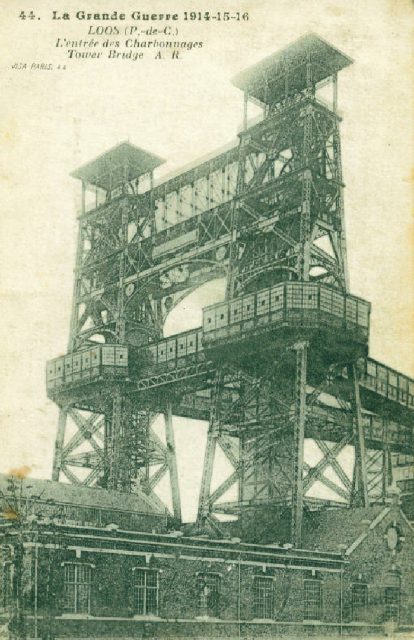
To their left was a position on the battlefield known as LONE TREE, and to their right, a German advanced trench into no mans land known as NORTHERN SAP.
The battlefield was overlooked by the remnants of the pre war mining industry, large slag heaps that granted the Germans extensive views of the British positions.
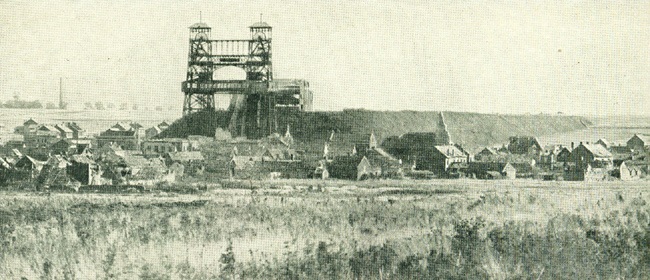
On the 25th September, George (who by now would be considered an experienced soldier) faced the German trenches once more, this time it was at “The Battle of Loos” It would appear George made it again to the middle of no mans land and for another time he probably had to try and take cover from machine gun fire and also the gas. The position that he made it to is well known as “The Lone Tree” and it was marked on all the maps at the time. The green line shows the German front line trench position.
Alas this was as far as he got. George died there and was buried just south of the Lone Tree together with four other men from the 2/RSR.
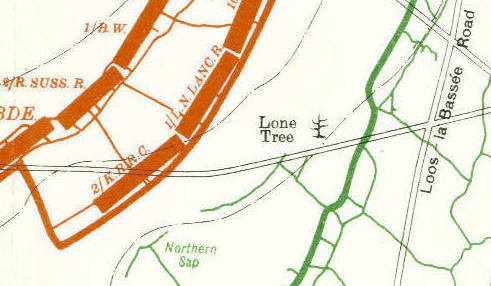
Memories from an unknown old soldier – About the Battle of Loos
25th September 1915, 2nd Royal Sussex Regiment
“We arrived in the trenches about 12.45am, took up our position and found the best place where we could to advance. It was a very nasty wet morning, our artillery started bombarding and clouds of gas was sent over from our trenches. One could not see anything more than 50 yds to the front. All our boys seemed quite happy and cheerful, about 06.00am we received orders to charge, over we got, and advanced about 400 yards only to be met by clouds of gas and a murderous rifle fire from the Germans. Our men were falling fast, some gassed, some shot, and some almost blown to pieces.
We were held up here for several minutes owing to the gas, we had already lost about four out of our ten officers. We received orders from our officer to make another dash. We had only got about five yards when our sergeant fell (gassed) and then our officer followed him-shot. We had then five officers left but we did not mean to be beaten although it seemed impossible to advance any further, but it had to be done, so again we made a dash and got just in front of the German trench; and were held up again by gas and the rifle fire was worse than ever – it was murder. Men were falling like corn being mown down. We received orders to retire and had only just started to do so, when a sharp knife seemed to go in my back and right leg. I was wounded and helpless and lying near the German trench with our dead and wounded, but however I managed to get back to the British trenches”
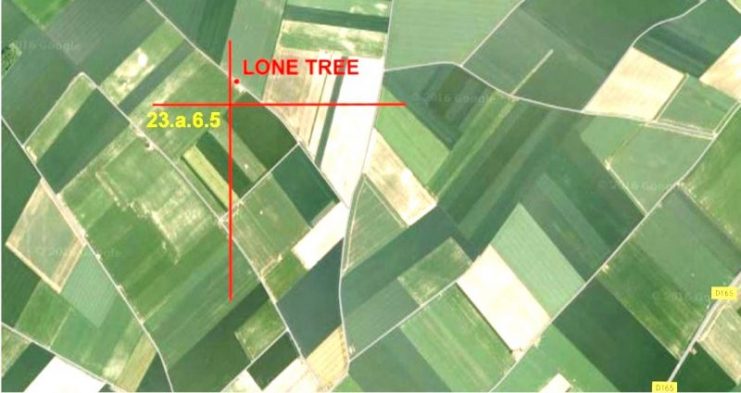
George was originally buried with L/CPL Frank Rowe along with three Unknown British Soldiers.
The Commonwealth War Graves Register notes that George’s body was then exhumed from a marked grave at map grid reference G.23.A.6.5. This grid reference places his initial place of burial (likely to be very proximate to his place of death) just to the south of LONE TREE, midway across No Mans Land.
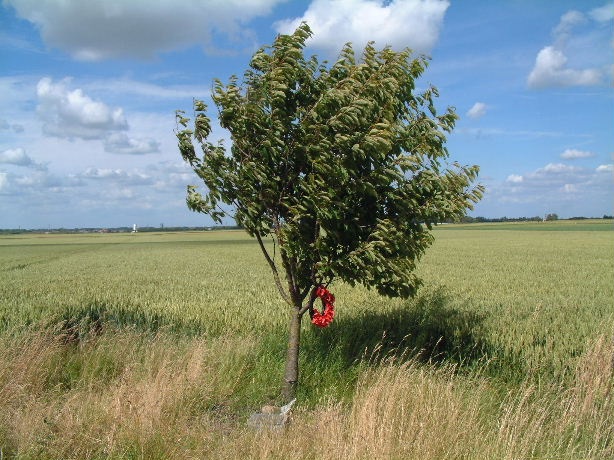
L/CPL Percy Frank ROWE, 8239, from Station Road, Arundel, enlisted 1905, served initially with the 2/RSR (the ‘home’ battalion) before transferring to the 1/RSR in India (the ‘overseas’ battalion – most regiments had one battalion at ‘home’ and one ‘overseas’ on service in the Empire). Percy enlisted for 8 years with the Colours and 5 years with the Reserve, left Regular service in 1913 and was mobilised at the start of the war due to his Reserve status. Landed in France on 12/08/1914.
The five bodies were moved to DUD CORNER CEMETERY, and reinterred in graves Plot 6. Row H. Graves 7-11.
At this stage it appears that the three Unknown British Soldiers were identified as:
L/CPL Charles GLANFIELD, 1377,
L/CPL Charles E JUDGE, 2292,
PTE Charles Richard FITSELL, GS/932, landed in France 19/01/1915.
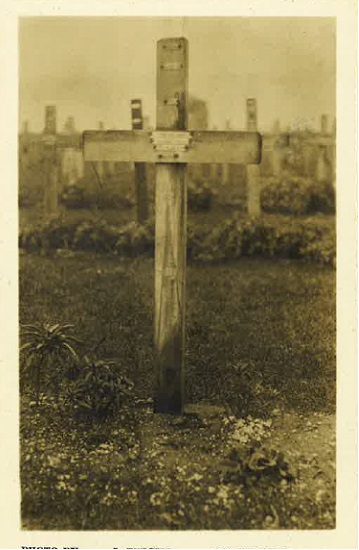
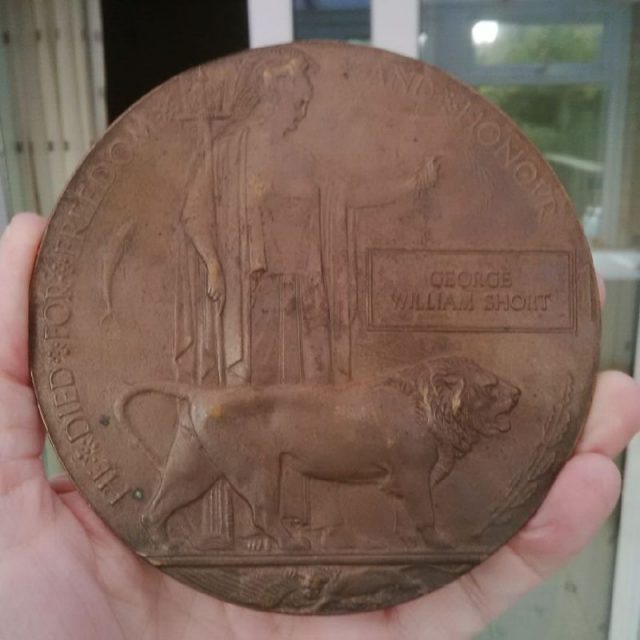
Dud Corner military cemetery. In remembrance of the fallen in the “Battle of Loos”
George’s position is: Plot 6 – row H – grave 8.
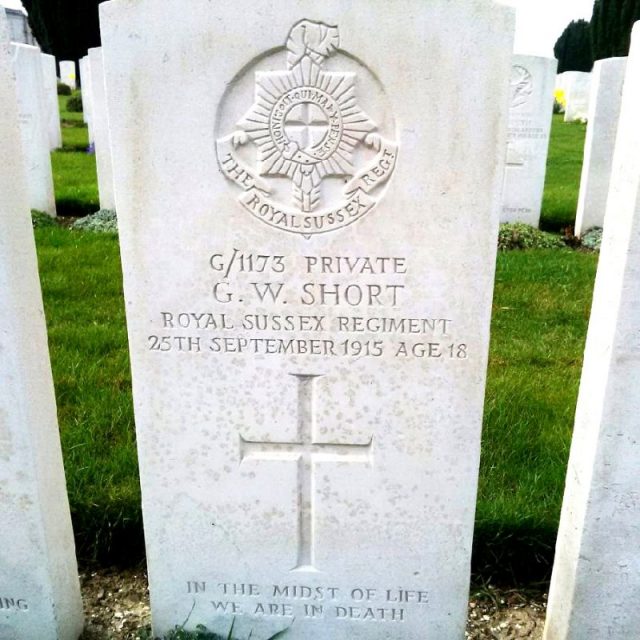
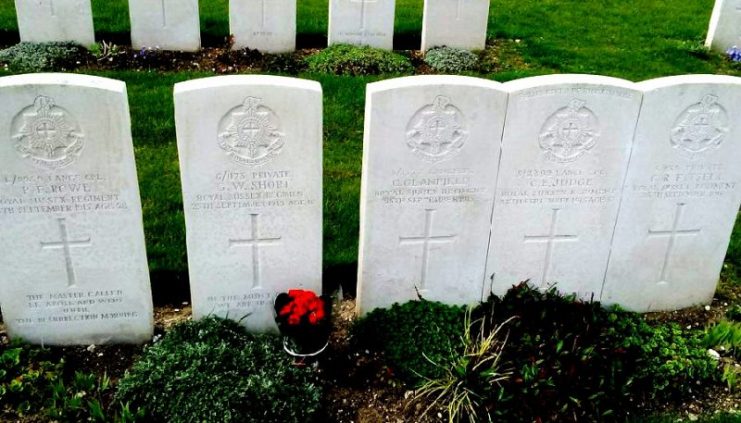
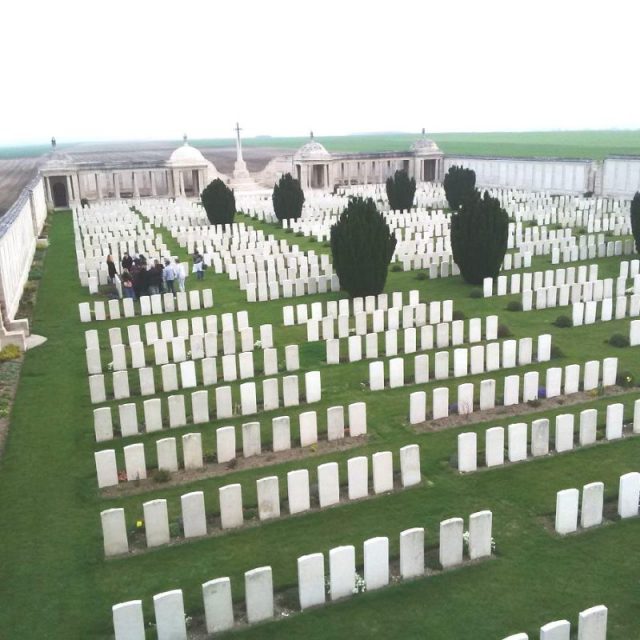
Southwick & Fishersgate War Memorial
Private George William Short was posthumously awarded: The 1915 Star, The British War Medal and The Victory Medal. He is commemorated on the Southwick & Fishersgate War Memorial, Sussex.
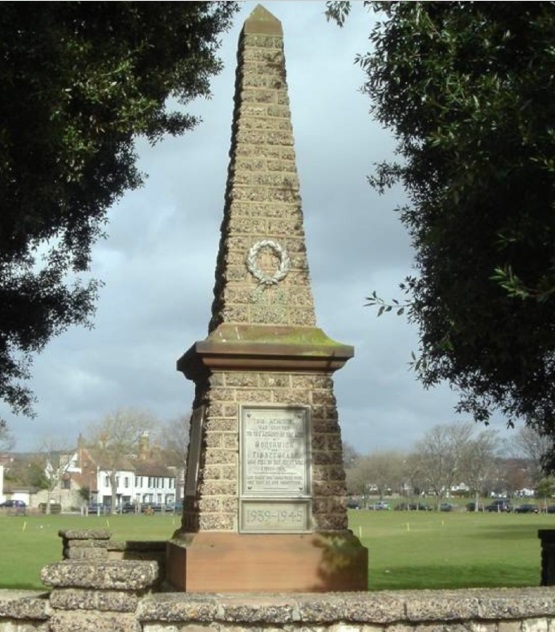
The original “Lone Tree” was cut down after the battle, many veterans taking sections of it away as souvenirs. After the war it was never replaced, it was not until 1995 that a new tree was planted on the site by members of the western front association and a small memorial erected.
George William Short was my great Uncle, his sister Dorothy Rosabelle Natalie was my grandmother.
I discovered George’s forgotten letter in the archives of the Sussex Daily News 101 years later, the immediate pain is less, but the direct connection and sadness is as real.
I am led to believe his mother Martha never got over the loss of George, the three medals he was posthumously awarded have not been kept in the family and sadly his handwritten letter has not been handed down.
I am left wondering if his mum “Martha” sent that small parcel to him.
If she did I do hope that he received it.
My thanks go to Andy Bailey, who has been so knowledgeable and helpful in obtaining and extracting some of the details contained in this story of George.
Frederick William Bowles
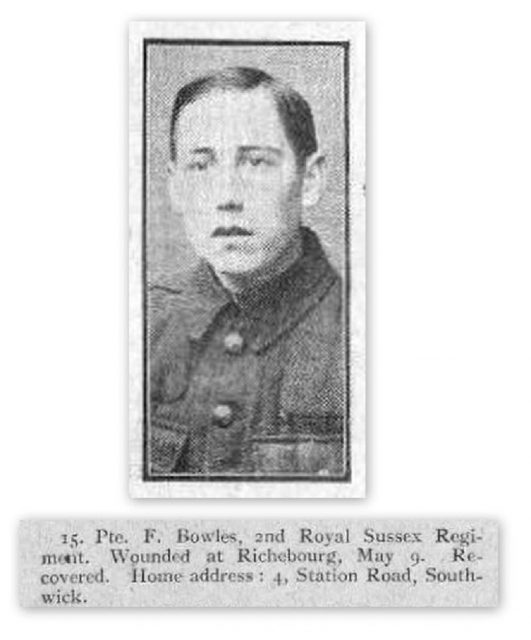
Frederick William Bowles birth registered Mar quarter of 1896 in Steyning registration district Which covered Southwick) in 1901 he was living at 3 Butts Road, Southwick, with his mother as head of the family. She was described as married not widowed (and a dressmaker) so we can assume Frederick Isaac was elsewhere (he didn’t come up on a search) James Bowles was living at the house and listed as brother and was a fisherman so it may be reasonable to assume that Frederick Isaac was also a fisherman and was at sea on the night of the census – 31 March 1901. Frederick had a brother James, who was born 1900
Frederick William Bowles married Louise Duchemin 18 Feb 1922 at Croydon, St John, Surrey. They would not seem to have had children.
In 1939 Frederick was a Dyer/Dying Manager and he gave his birth date as 23 December 1895. Frederick and Louise were living at 36 Layton Crescent , Croydon (as per the 1939 Register, taken 28th September 1939)
Frederick died 4 Dec 1975 in Croydon, registered in December quarter in Croydon district.
Entry in the National Probate Register Name: Frederick William Bowles
Death Date: 4 Dec 1975
Death Place: Croydon
Probate Date: 3 Feb 1976
Registry: Brighton
Percy Charles Smith
Birth registered in Steyning district in March quarter of 1895. Baptism record : Name: Percy Charles Smith
Gender: Male
Baptism Date: 14 Mar 1895
Baptism Place: Southwick, Sussex, England In 1911 he was living at 10 Adur Terrace, Southwick, along with his father William, aged 62, a fisherman (on his own account so presumably he had a boat) , mother Ann aged 57, sister Mable (sic) aged 23, a dressmaker, and his brother William aged 21 who was a fireman on a dredger, employed by the Harbour Trustees. Percy himself was a greengrocers boy.
After this, Percy Charles becomes difficult to track – if he is one of the numerous Percy Charles Smith on record he was less than truthful about his date of birth, so the waters become very muddy. It is plain to see, however, that he did not remain in the Southwick area, as there are no entries to corroborate this area.
Location information: Loos-en-Goheile is a village 5 kilometres north-west of Lens. Dud Corner cemetery is located about 1 kilometre along the N43 on the Bethune road. The memorial commemorates over 20,000 officers and men who have no known grave in the surrounding area.
Historical information: The name for Dud corner is believed to be due to the large number of unexploded enemy shells found in the neighbourhood after the Armistice. The only burials here during hostilities were 5 graves of four officers and a private. The remainder of the graves were brought in later from smaller cemeteries and isolated positions near Loos. The great majority of the dead buried here fell in the Battle of Loos 1915.
All photos are provided by the author.
